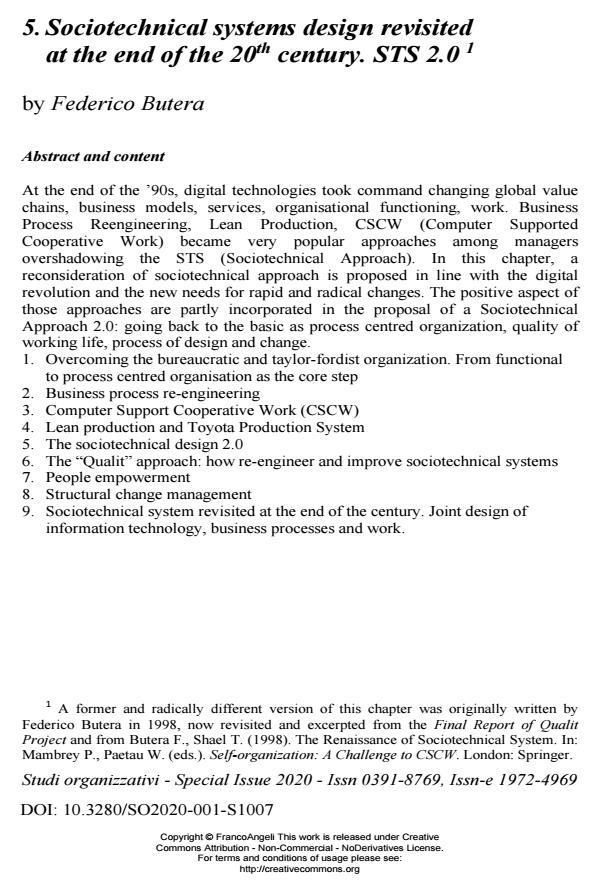Sociotechnical systems design revisited at the end of the 20th century. STS 2.0
Titolo Rivista STUDI ORGANIZZATIVI
Autori/Curatori Federico Butera
Anno di pubblicazione 2020 Fascicolo 2020/suppl. 1
Lingua Inglese Numero pagine 24 P. 102-125 Dimensione file 361 KB
DOI 10.3280/SO2020-001-S1007
Il DOI è il codice a barre della proprietà intellettuale: per saperne di più
clicca qui

FrancoAngeli è membro della Publishers International Linking Association, Inc (PILA)associazione indipendente e non profit per facilitare (attraverso i servizi tecnologici implementati da CrossRef.org) l’accesso degli studiosi ai contenuti digitali nelle pubblicazioni professionali e scientifiche
At the end of the ’90s, digital technologies took command changing global value chains, business models, services, organisational functioning, work. Business Process Reengineering, Lean Production, CSCW (Computer Supported Cooperative Work) became very popular approaches among managers overshadowing the STS (Sociotechnical Approach). In this chapter, a reconsideration of sociotechnical approach is proposed in line with the digital revolution and the new needs for rapid and radical changes. The positive aspect of those approaches are partly incorporated in the proposal of a Sociotechnical Approach 2.0: going back to the basic as process centred organization, quality of working life, process of design and change.
1. Overcoming the bureaucratic and taylor-fordist organization. From functional to process centred organisation as the core step
2. Business process re-engineering
3. Computer Support Cooperative Work (CSCW)
4. Lean production and Toyota Production System
5. The sociotechnical design 2.0
6. The "Qualit" approach: how re-engineer and improve sociotechnical systems
7. People empowerment
8. Structural change management
9. Sociotechnical system revisited at the end of the century. Joint design of information technology, business processes and work.
- Verso una semplificazione possibile (e desiderabile) della regolazione urbanistica Stefano Moroni, in TERRITORIO 98/2022 pp.24
DOI: 10.3280/TR2021-098004 - Democratizing Platform Work from Below Paolo Borghi, in STUDI ORGANIZZATIVI 2/2024 pp.51
DOI: 10.3280/SO2023-002003 - Organizational democracy at work. Shaping participation through strategic planning in university Carmela Barbera, Roberto Lusardi, Stefano Tomelleri, in STUDI ORGANIZZATIVI 2/2024 pp.162
DOI: 10.3280/SO2023-002007 - Paradigmi e metodi per gli architetti del nuovo lavoro Federico Butera, in STUDI ORGANIZZATIVI 1/2022 pp.217
DOI: 10.3280/SO2022-001010 - Still in search of organizational democracy: exploring new opportunities and constraints Luca Carollo, Lisa Dorigatti, Annalisa Murgia, Simon Parker, Thomas Steger, in STUDI ORGANIZZATIVI 2/2024 pp.7
DOI: 10.3280/SO2023-002001
Federico Butera, Sociotechnical systems design revisited at the end of the 20th century. STS 2.0 in "STUDI ORGANIZZATIVI " suppl. 1/2020, pp 102-125, DOI: 10.3280/SO2020-001-S1007